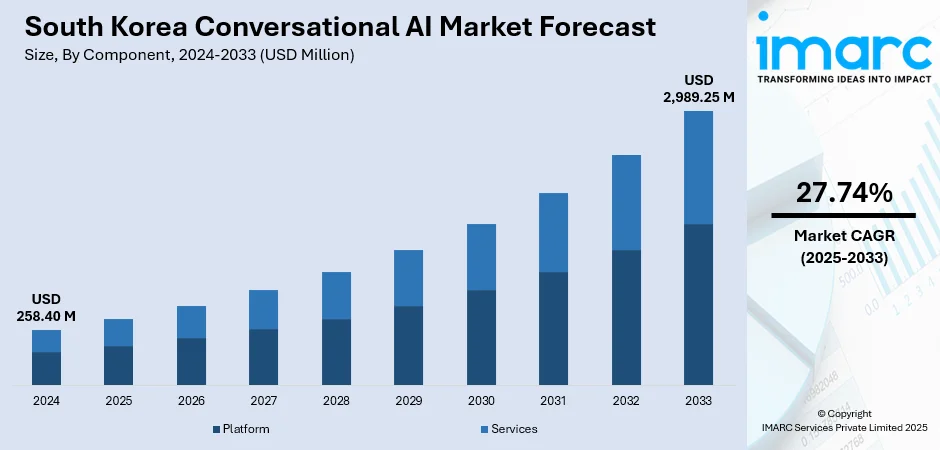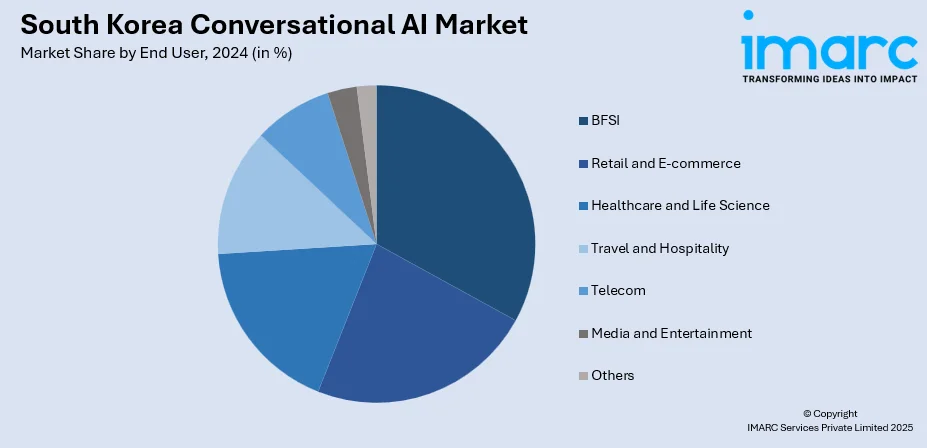
South Korea Conversational AI Market Size, Share, Trends and Forecast by Component, Type, Technology, Deployment Mode, Organization Size, End User, and Region, 2025-2033
South Korea Conversational AI Market Overview:
The South Korea conversational AI market size reached USD 258.40 Million in 2024. Looking forward, IMARC Group expects the market to reach USD 2,989.25 Million by 2033, exhibiting a growth rate (CAGR) of 27.74% during 2025-2033. Mass adoption of smart devices in South Korea is playing a major role in driving the adoption of conversational technologies. Moreover, the country’s fast-paced technological innovations in artificial intelligence (AI) are a major growth driver of the industry. Apart from this, the heightened number of businesses focusing on saving operational costs while ensuring high customer satisfaction is expanding the South Korea conversational AI market share.
|
Report Attribute
|
Key Statistics
|
|---|---|
|
Base Year
|
2024
|
|
Forecast Years
|
2025-2033
|
|
Historical Years
|
2019-2024
|
| Market Size in 2024 | USD 258.40 Million |
| Market Forecast in 2033 | USD 2,989.25 Million |
| Market Growth Rate 2025-2033 | 27.74% |
South Korea Conversational AI Market Trends:
Technological Innovations and Artificial Intelligence (AI) Adoption
South Korea's fast-paced technological innovations in AI are a major growth driver of the conversational AI industry. The nation is characterized by its robust emphasis on AI technology research and development (R&D), such as natural language processing (NLP) and machine learning (ML). This is leading to the development of more advanced conversational AI solutions that can read, comprehend, and answer human questions more accurately. These technologies are being applied across multiple industries, such as customer service, health, finance, and retail, enhancing efficiency and user experience. The government of South Korea's focus on AI innovation via initiatives such as the "AI National Strategy" also drives the development and implementation of AI-driven solutions. This sharp emphasis on AI research and development (R&D) is not strengthening local competence but also making South Korea the global leader in conversational AI. In 2025, LG Group, a major South Korean conglomerate, introduced a new iteration of its leading AI model capable of providing either rapid replies to questions or generating answers through a methodical reasoning approach. Named Exaone 4.0, the hybrid AI model is created by LG AI Research. LG AI Research stated that Exaone 4.0 is capable of processing requests in Spanish, alongside Korean and English.

To get more information on this market, Request Sample
Increased Need for Automation and Cost Savings
As South Korean businesses are encouraged to save operational costs while ensuring high customer satisfaction, demand for automation tools like conversational AI is increasing. Firms across sectors, particularly in customer support, are implementing chatbots, virtual assistants, and AI-based call centers to service repetitive queries, facilitate transactions, and provide 24/7 assistance, thereby supporting the South Korea conversational AI market growth. Such solutions minimize the use of human operators, thus decreasing operating expenditures and enhancing scalability. Further, AI applications can rapidly process high amounts of data, providing companies with insights that would be both time- and money-consuming for humans to examine. The growing demand for companies to remain competitive in an increasingly changing digital world drives the adoption of conversational AI as an indispensable tool for maximizing operational effectiveness.
Mass Adoption of Smart Devices by Consumers and Businesses
Mass adoption of smart devices in South Korea has played a major role in driving the usage of conversational AI. With high penetration rates of smartphones, smart speakers, and connected home devices, consumers in South Korea are increasingly exposed to AI-based voice assistants. With these devices increasingly part of daily routines, the market demand for more sophisticated and personalized conversational AI applications grows. Companies are taking advantage of these platforms to increase customer interaction, presenting a smoother, more user-friendly experience in the form of voice-activated services and automated assistance. Further, with South Korea's population increasingly becoming technology driven and dependent on intelligent devices, there has been an increased expectation for conversational AI technology to be able to deliver mature and context-aware interactions, leading to increased innovation and growth in the field. In 2024, South Korean tech company Samsung announced the launch of AI-enabled Galaxy S24 phones. The Note Assist in Samsung Notes includes AI-created summaries, template generation that simplifies notes using pre-existing formats, and cover creation for easy identification of notes with a short preview. For voice recordings, even with several speakers, Transcript Assist utilizes AI and Speech-to-Text technology to transcribe, summarize, and translate recordings.
South Korea Conversational AI Market Segmentation:
IMARC Group provides an analysis of the key trends in each segment of the market, along with forecasts at the country and regional levels for 2025-2033. Our report has categorized the market based on component, type, technology, deployment mode, organization size, and end user.
Component Insights:
- Platform
- Services
- Support and Maintenance
- Training and Consulting
- System Integration
The report has provided a detailed breakup and analysis of the market based on the component. This includes platform and services (support and maintenance, training and consulting, and system integration).
Type Insights:
- Intelligent Virtual Assistant (IVA)
- Chatbots
A detailed breakup and analysis of the market based on the type have also been provided in the report. This includes intelligent virtual assistant (IVA) and chatbots.
Technology Insights:
- Machine Learning
- Deep Learning
- Natural Language Processing
- Automatic Speech Recognition
The report has provided a detailed breakup and analysis of the market based on the technology. This includes machine learning, deep learning, natural language processing, and automatic speech recognition.
Deployment Mode Insights:
- Cloud-based
- On-premises
A detailed breakup and analysis of the market based on the deployment mode have also been provided in the report. This includes cloud-based and on-premises.
Organization Size Insights:
- Large Enterprises
- Small and Medium-sized Enterprises
The report has provided a detailed breakup and analysis of the market based on the organization size. This includes large enterprises and small and medium-sized enterprises.
End User Insights:

- BFSI
- Retail and E-commerce
- Healthcare and Life Science
- Travel and Hospitality
- Telecom
- Media and Entertainment
- Others
A detailed breakup and analysis of the market based on the end user have also been provided in the report. This includes BFSI, retail and e-commerce, healthcare and life science, travel and hospitality, telecom, media and entertainment, and others.
Regional Insights:
- Seoul Capital Area
- Yeongnam (Southeastern Region)
- Honam (Southwestern Region)
- Hoseo (Central Region)
- Others
The report has also provided a comprehensive analysis of all the major regional markets, which include Seoul Capital Area, Yeongnam (Southeastern Region), Honam (Southwestern Region), Hoseo (Central Region), and others.
Competitive Landscape:
The market research report has also provided a comprehensive analysis of the competitive landscape. Competitive analysis such as market structure, key player positioning, top winning strategies, competitive dashboard, and company evaluation quadrant has been covered in the report. Also, detailed profiles of all major companies have been provided.
South Korea Conversational AI Market Report Coverage:
| Report Features | Details |
|---|---|
| Base Year of the Analysis | 2024 |
| Historical Period | 2019-2024 |
| Forecast Period | 2025-2033 |
| Units | Million USD |
| Scope of the Report |
Exploration of Historical Trends and Market Outlook, Industry Catalysts and Challenges, Segment-Wise Historical and Future Market Assessment:
|
| Components Covered |
|
| Types Covered | Intelligent Virtual Assistant (IVA), Chatbots |
| Technologies Covered | Machine Learning, Deep Learning, Natural Language Processing, Automatic Speech Recognition |
| Deployment Modes Covered | Cloud-based, On-premises |
| Organization Sizes Covered | Large Enterprises, Small and Medium-sized Enterprises |
| End Users Covered | BFSI, Retail and E-Commerce, Healthcare and Life Science, Travel and Hospitality, Telecom, Media and Entertainment, Others |
| Regions Covered | Seoul Capital Area, Yeongnam (Southeastern Region), Honam (Southwestern Region), Hoseo (Central Region), Others |
| Customization Scope | 10% Free Customization |
| Post-Sale Analyst Support | 10-12 Weeks |
| Delivery Format | PDF and Excel through Email (We can also provide the editable version of the report in PPT/Word format on special request) |
Key Questions Answered in This Report:
- How has the South Korea conversational AI market performed so far and how will it perform in the coming years?
- What is the breakup of the South Korea conversational AI market on the basis of component?
- What is the breakup of the South Korea conversational AI market on the basis of type?
- What is the breakup of the South Korea conversational AI market on the basis of technology?
- What is the breakup of the South Korea conversational AI market on the basis of deployment mode?
- What is the breakup of the South Korea conversational AI market on the basis of organization size?
- What is the breakup of the South Korea conversational AI market on the basis of end user?
- What is the breakup of the South Korea conversational AI market on the basis of region?
- What are the various stages in the value chain of the South Korea conversational AI market?
- What are the key driving factors and challenges in the South Korea conversational AI market?
- What is the structure of the South Korea conversational AI market and who are the key players?
- What is the degree of competition in the South Korea conversational AI market?
Key Benefits for Stakeholders:
- IMARC’s industry report offers a comprehensive quantitative analysis of various market segments, historical and current market trends, market forecasts, and dynamics of the South Korea conversational AI market from 2019-2033.
- The research report provides the latest information on the market drivers, challenges, and opportunities in the South Korea conversational AI market.
- Porter's five forces analysis assist stakeholders in assessing the impact of new entrants, competitive rivalry, supplier power, buyer power, and the threat of substitution. It helps stakeholders to analyze the level of competition within the South Korea conversational AI industry and its attractiveness.
- Competitive landscape allows stakeholders to understand their competitive environment and provides an insight into the current positions of key players in the market.
Need more help?
- Speak to our experienced analysts for insights on the current market scenarios.
- Include additional segments and countries to customize the report as per your requirement.
- Gain an unparalleled competitive advantage in your domain by understanding how to utilize the report and positively impacting your operations and revenue.
- For further assistance, please connect with our analysts.
 Request Customization
Request Customization
 Speak to an Analyst
Speak to an Analyst
 Request Brochure
Request Brochure
 Inquire Before Buying
Inquire Before Buying




.webp)




.webp)












